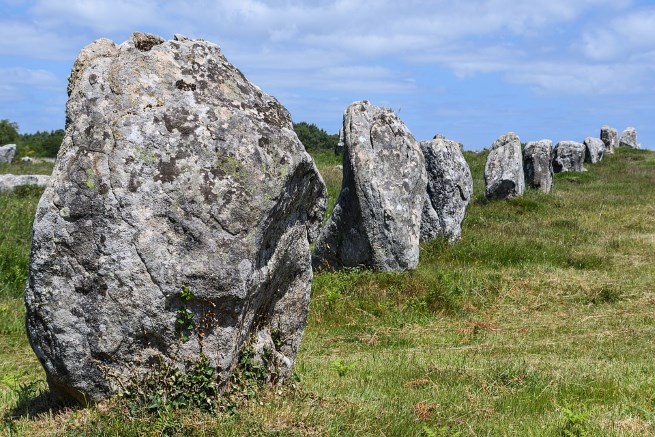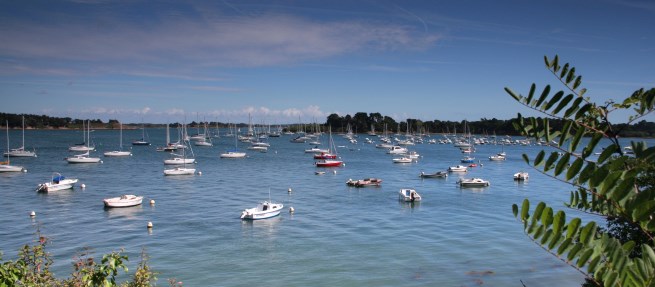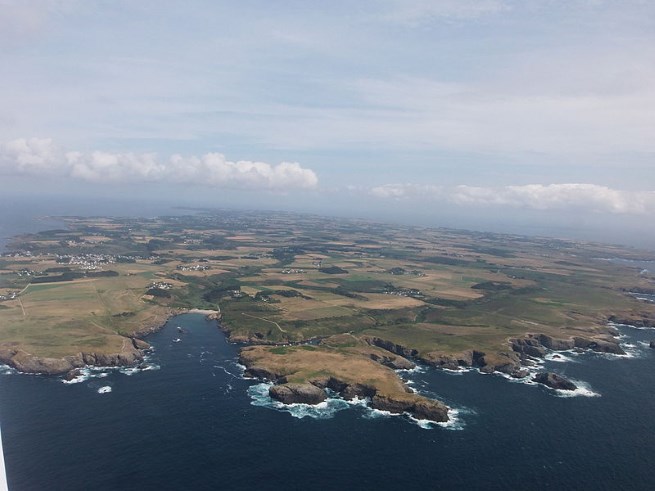Island Hopping in Morbihan

Three skinny lads have just executed a perfect mid-air somersault, splashing into the Etel estuary, narrowly avoiding their heads on the stone bridge. Elderly locals tut with disapproval (“La folie de jeunesse!”) which only spurs the lads on to further acrobatics.
Out in the estuary behind them is one of the oddest sights I’ve ever seen in France. On a tiny islet there’s a 19th Century stone bungalow with blue shutters. It’s high tide which means the bungalow isn’t much bigger than the islet itself. Should the occupants stumble out of the front door, they’d risk a rude dunking.
There are no occupants left now, though. The islet’s known as Nichtarguer, and used to be home to an oyster farmer. Nowadays it just sits empty, rather forlorn, a resting post for seabirds and lichen.
Morbihan, a coastal department in southern Brittany, on France’s Atlantic coast, has plenty of oddities from the past like this. Most obvious are the thousands of megalithic stones – or menhirs, as they’re known – scattered about the countryside. While nowhere near our Stonehenge in size, they are remarkable for their sheer number. Dating from as long as 8,000 years ago, it’s estimated there are around 1,200 of them across the region, ranging from solitary stones – the sort Asterix’s sidekick Obelix used to haul around – to multiple alignments.
Carnac is the best place to see them. This seaside town, at the western point of Quiberon Bay, features more than 3,000 menhirs. Erected during the Neolithic period, between 4500 BC and 2000 BC, no one’s quite sure who put them there, or why. Some experts believe they’re astronomical markers, others territorial boundaries. Strange legends abound that they were placed there by sub-human giants (hence Obelix’s character), or magicked there by korrigans, the Breton equivalent of Irish leprechauns. Whatever the case, unlike Stonehenge, you’re free to climb all over some of them if you wish. (Although there is talk of fencing them all off in the future.)
While the menhirs are completely lifeless, you can’t say that about the town of Carnac, especially in the summer season. One afternoon we wandered through Carnac-Plage, the seaside half of the town, and found ourselves at L’Igloo, one of the finest ice-cream shops you’ll find in France. (No exaggeration.)
First of all you choose the type of cone you want your ice-cream to come in: dark chocolate, white chocolate, nutty, natural. Then comes the complicated part – choosing your ice-cream flavour. The choice is mind-boggling. Carrot, Champagne, Malibu, Nutella, candy floss, whisky, potato, even beetroot. If you’re in this part of Brittany, do not miss L’Igloo. It really is worth the detour. Maybe give the beetroot flavour a miss, though.
In need of something a touch more savoury on the palate, that evening we headed for Carnac’s bars for an apéritif. If you want to observe France’s BCBGs (bon chic, bon genre, as the French call their preppies), in action, this is the place to do it. Sporting chino trousers, deck shoes, polo shirts and cashmere jumpers tied round their shoulders, they love to spend their summer holidays in this part of Brittany. The Côte d’Azur is a bit too bling for their liking; a bit too nouveau riche. France’s old money prefers the twisting coast and rocky cliffs of southern Brittany.
There’s a slight bohemian feel to this part of the world, too. As one of France’s more important magazines, Le Nouvel Observateur, describes it: “Morbihan attracts writers and artists like a lover. They fall for the charm of this Breton Riviera, light years away from the jet-set beaches of the Côte d’Azur. Here, bling bling gives way to the gling gling of sea birds. Everywhere you look there are mysterious beaches, underwater gardens, friendly waves, peace and tranquility.”
Without doubt, Morbihan’s stand-out physical feature is its gulf. Golfe du Morbihan is a huge natural harbour, just 1,000m wide at its mouth, but around 20kms long and 15kms wide in its interior: 100 square kms in all. In Breton ‘mor bihan’ means ‘little sea’.

Golfe du Morbihan, photo: Nono vlf
Islands galore
Legend has it there used to be 365 islands in the gulf, one for every day of the year. Nowadays, with the sea levels much higher, it’s closer to one for every week of the year.
Some, like L’Ile aux Moines and L’Ile d’Arz, are huge with their own thriving communities, others just large rocks populated by birds. The roster of names, mostly Breton, is almost poetic: Grand Veizit, Ile Creizic, Ile Brannec, Ile Govihan, Er Lannic, Hent Tenn, Grand Logoden, Inezic, Ile Stibiden, Ile Godec, Penn Blei. And flitting between them all are thousands of vessels – sailing yachts, pleasure cruisers, car ferries, rowing boats.
If you only get the chance to visit one gulf island, aim for Gavrinis, right near the mouth of the gulf, with its astounding megalithic site, the Cairn de Gavrinis. Burial chambers, ancient carvings and axe-heads may not be your thing, but it’s still worth seeing. The passageway into the tomb is 14 metres long, and built so that on the winter solstice the sun shines directly into the burial chamber. Indiana Jones would have a field day.
But Morbihan’s finest island of all is beyond the gulf; 17 miles beyond it, to be precise. The largest of all of Brittany’s islands, Belle-Ile-en-Mer is the same size as Manhattan Island in New York City. But in appearance and atmosphere, it couldn’t be more different.

Belle-Ile-en-Mer, photo: Franck-fnba
To get there you catch one of the many ferries leaving from the tip of the Quiberon peninsula, a bizarre stretch of land that narrows to as little as 50 metres in some places. Drive all the way to the end of the peninsula and then try to park near the port (virtually impossible in summer) before boarding one of the regular ferry services. Be ready to pay through the nose, though – around 25 euros last time we checked. As a foot passenger it’s cheaper to cross the English Channel.
But it’s well worth it once you arrive. With its stunning beaches, beautiful villages (especially Sauzon, near the northern tip), and, crucially, very few cars, it’s a great way to escape the tourist crowds on the mainland.
Destination of choice
As your ferry approaches the island, from a distance first you see the tall houses and yachts in the main harbour town, Le Palais. High up, just to the north, are the star-shaped granite fortifications of the Citadelle. With its underground passageways, jail cells and dungeons, it has incarcerated some infamous enemies of the French state over the years including Algerian, Haitian and home-grown revolutionaries, German POWs during World War I and Allied POWs during World War II. Even Karl Marx spent a brief period here at Monsieur Le President’s leisure.
But this is no prison island. Its natural beauty has attracted many celebrities on the right side of the law, too, including: Gustave Flaubert, Marcel Proust, André Gide, Henri Matisse, Sarah Bernhardt, Claude Monet, Francois Mitterand and, more recently, Johnny Depp.
It was Matisse who summed up Belle-Ile-en-Mer the best, calling it “le plus beau coin de France”. He certainly knew a thing or two about beauty.
Share to: Facebook Twitter LinkedIn Email
Leave a reply
Your email address will not be published. Required fields are marked *



